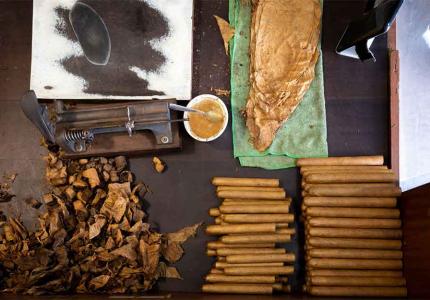
Few topics surrounding cigars attract a greater disparity of views than the effect that wrappers have on the taste of cigars.
Some people are so influenced by the colour that they are convinced that light-brown wrappers promise light tasting smokes and conversely, that dark wrappers threaten overpowering flavours.
Others insist that wrappers have no effect whatsoever on the taste. After all, a wrapper is only half of a single leaf, often wafer thin because it comes from a shade grown plant. How could its influence be significant when compared to the cluster of three or four different types of sturdy, sun-grown filler leaves blended uniquely to fulfil the goals for the specific tastes sought by different brands.
Forty years ago when I joined the Havana trade, my schooling was clear. Wrappers were for appearance not taste. Imagine my surprise when, a dozen or so years later at the start of the cigar boom in the US, I heard a leading Dominican Republic manufacturer state in public that wrappers could account for no less than 70% of the ultimate taste of his products.
I was tempted to suggest that if his wrappers could prove so dominant, then his fillers must be rather insipid, but I didn’t because I believed that there was a sounder explanation for the role of the wrapper.
Wrappers come in a wide variety of colours, caused principally by where they are grown on the tobacco plant. The leaves at the bottom of the plant, which are the oldest and thinnest, will, after curing and fermentation, produce the lightest colours; whereas the younger, thicker leaves from the top of the plant will result in much darker colours.
Throughout the production process, agricultural and industrial, a huge amount of effort goes into ensuring that the final array of cigars in any box, bundle or pack are perfectly colour matched. Ultimately the range of tones will fall into one of five colours description:
It follows that “Claro wrappers” will come from the bottom leaves of a plant, “Maduro wrappers” from the leaves at the top, and the other classifications from the levels in between.
There is another factor that varies along the same lines, namely the sugar content in the leaves. There is more sugar in the Maduro leaves from the top of the plant, and much less in Claro leaves from the bottom.
As a result, you find that very dark maduro leaves bring sweetness to a cigar’s taste that is apparent even when you first place it unlit between your lips.
Conversely, light coloured wrapper leaves add dryness to the cigar’s taste. My contention is that wrappers do make a significant contribution to the taste of a cigar, but not with regard to its fullness or lightness of flavour. Instead they add what I describe as a top taste based on an axis from dry to sweet, subject to their colour.
As a personal preference, I find the sweetness of darker wrappers goes best with rich, earthy, full flavoured filler blends, whereas there is a natural compatibility between the dryness of pale-brown wrappers with more delicate confections.
As a result, taking Cuba’s two most popular Robusto as examples, I would always choose a Partagas series D No.4 with a Colorado or Colorado Maduro wrapper, and a Hoyo De Monterrey Epicure No.2 wrapped in a Claro leaf.
Let me make it clear that this is not a rule; it is merely the personal taste, we say here at Taylors Tobacconists in Bond Street Brighton & Hove UK. There are many respected aficionados who order their Epicure No.2 with darker wrappers or their D 4s with light ones.
It is up to you to decide what suits your palate. Over the years, the market’s preferences have changed. When I started out Claro wrappers were all the rage. Up until the 1970’s, some Cuban factories marked their boxes with the colour of their contents, either with the full names – Claro, Colorado Claro and so on. Or sometimes with a code – CCC for Claro, CC for Colorado Claro, and C for Colorado. They noted the colours on their invoices, too, as can be seen on the examples from Partagas in 1939 for Ramon Allones. Most of the cigars are Claro (CCC) even for a full flavoured brand.
Today the variety of colours available from Cuba is much wider, particularly when you include such specialities as the Limited Edition lines. If you would like to know more about this topic, do not hesitate to contact us today.
Registered Address: Taylors Tobacconists Ltd
19 Bond Street, Brighton, East Sussex, BN1 1RD
Tel: 01273 606110
UK Company Registration No: 04463895




Subscribe to our newsletter to stay up to date on our latest products

THIS WEBSITE CONTAINS IMAGES OF AGE RESTRICTED PRODUCTS. YOU MUST BE AT LEAST 18 YEARS OF AGE TO ENTER. WE RUN CHECKS ON ORDERS AND WILL NOT DELIVER AN ORDER WHERE WE BELIEVE THE RECIPIENT IS UNDER 18.
PLEASE LEAVE NOW IF YOU ARE UNDER 18.